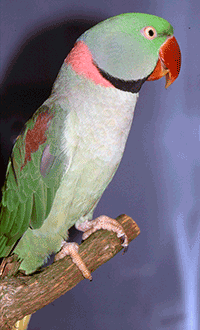 by Jim Hayward
by Jim Hayward
ORIGINAL HOMELAND:
A vast expanse of the near and far east, from Afghanistan through Pakistan, India, Ceylon, Burma, Thailand and on to Indo-China.
NATURAL HABITAT:
This adaptable species is to be found in a variety of habitats, from riverine forest, to arid thinly wooded country, from highland to lowland, from the vicinities of villages to the gardens and parks of towns.
STATUS IN THE WILD:
As common as to be seen in roosts numbering thousands in its strongholds, such as northern India, but sparsely represented at the peripheraries of its range.
STATUS IN AVICULTURE:
Always popular as pets since the days of Alexander the Great, nowadays becoming much more popular as a breeding aviary species.
LEVEL OF KEEPER'S EXPERIENCE:
Suitable for the novice with experience of keeping the smaller Indian Ringneck.
HARDINESS:
These parrakeets are known to be susceptible to frost bitten toes; apart from this, they are recognized as a hardy long lived species.
TYPE OF ACCOMMODATION:
It is a shame to keep a pair of such large and handsome parrakeets in a flight less than 15ft in length; the destructive habits of these birds dictate that the aviary must be strongly made to withstand their powerful mandibles, so wooden framework and thin mesh will be no obstacle whatever to the birds' escape - at least 16g welded mesh should be used and wooden framework covered with metal sheet or replaced by metal pipe or angle iron. A shelter is advisable.
TYPE OF DIET:
Seeds and grains; sunflower, safflower, mixed canary, mixed millet, maize, wheat, etc; a daily mixed portion of fruit and vegetable, apple, orange, grapes, berries, corn-on-the-cob, peas, celery, cabbage, carrot, cabbage, chickweed and other wild food as available. Wholemeal bread and milk, and germinated seed should be given during the breeding season; a lot of cuttlefish is eaten (or wasted) and should always be available.
SEXING:
Only cocks have black neck rings and pink collars, but both sexes have maroon shoulder patches. The tails of hens are shorter than those of the cocks, but those of immatures are still shorter.
SEXUAL MATURITY:
Alexandrines do not attain full adult plumage until they are three years old, and are likely to begin attempts to breed from three to four years old.
NESTING SEASON IN BRITAIN:
Breeding can commence as early as February or March but it may be wiser to hold them back til March or April - they are known to go to nest as late as June.
TYPE OF NEST:
Suitable nests measure 10" square by 18" to 24" deep; made of inch thick exterior plywood and reinforced at strategic points with metal to save frequent repair. Initial filler of crumbled rooted wood and soft sieved sand, with offcuts of wood placed inside which the hen will quickly reduce to nest litter.
USUAL NUMBER OF EGGS:
Two to four eggs are usual.
INCUBATION PERIOD:
Incubation takes 22/23 days.
USUAL NUMBER OF YOUNG:
Two to three.
FLEDGING AGE:
About seven weeks.
USUAL NUMBER OF CLUTCHES:
A single clutch per season is usual.
NESTING HABITS:
During courtship, the cock's display consists of exaggerated advances, bowing, stretching, twirling and eye flashing, with shoulders thrust out. Only the hen incubates.
SPECIAL CONSIDERATIONS:
As with Ringnecks and Plumheads, 'hens' of pairs purchased as 'true pairs' can prove to be cocks after moulting; it is unwise to purchase cocks with the expectation of easily finding spare hens.
NOISE FACTOR:
High pitched far carrying but cheerful calls; could upset close neighbours.
AVAILABILITY:
Generally available.
COLOUR VARIETIES:
The first Lutino is reputed to have been imported into England in 1923, the shoulder patches of the Green bird are altered to orange red in the Lutino; about the same time, the first Blue was also imported and small numbers of both varieties were bred up, only to be lost during the ensuing war years. Lutinos and Blues are still rarities but do exist, however, in some cases colour varieties have been introduced into the Alexandrine via hybridization with the Indian Ringneck.
